|
Oxygen
Masks
One of the most critical features in the oxygen supply system is
the breathing mask. An oxygen mask is used for the purpose of
delivering oxygen to the user's respiratory system. Oxygen masks
are designed for either pressure breathing or continuous flow
regulators. The features such as microphones, amplifiers,
regulators, or connectors will be determined by the application.
All masks include some kind of face seal and an arrangement of
valves to direct the flow of inhaled and exhaled gases. The mask
provides facial protection from fire and projectiles.
Pressure-Demand Oxygen Mask Assemblies
The pressure-demand oxygen mask is used by air crew members who
wear fixed wing helmet assemblies and use oxygen routinely. The
pressure-demand oxygen mask is based on the MBU-12/P (Figure
1-36)
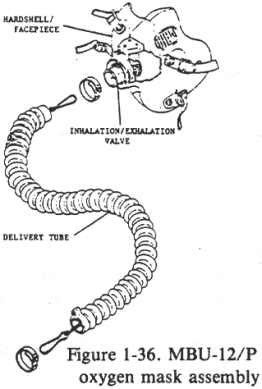
oxygen
mask subassembly. The MBU-12/P subassembly features an integral
hard shell (polysulphamate) face piece (silicone), flexible
silicone hose, and combination inhalation and exhalation valve.
Components must be added to or removed from the basic MBU-12/P
subassembly to obtain the desired oxygen mask configuration
(Figures 1-37 thru 1-43). The versatility of the pressure demand
oxygen mask allows it to be worn with chest mounted regulators
in tactical jets as well as panel mounted regulators and
walkaround bottles. A properly fitted oxygen mask is essential
to helmet retention in high speed ejections.
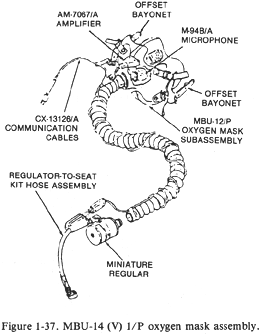
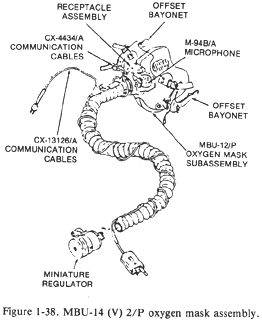
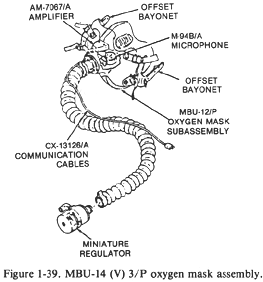
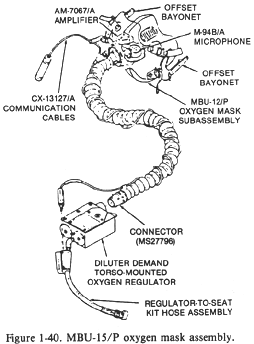
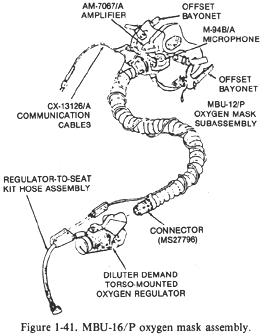
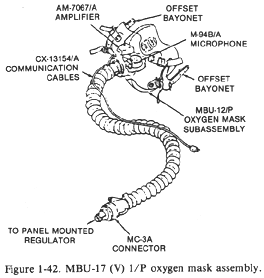
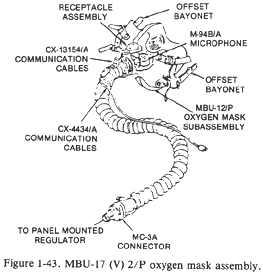
Quick-Don Oxygen Mask
The MBU-10/P Oxygen Mask Assembly (Figures 1-44, 1-45) consists
of a hanging suspension holder, a suspension assembly, an oxygen
mask assembly, a cable and plug assembly, and a dust cover. The
MBU-12/P oxygen mask subassembly is used and is supplied in one
size - regular. The Quick-Donning MBU-10/P oxygen mask assembly
permits the air crew to breathe gaseous oxygen. The oxygen
supply enters the face piece through the valve located at the
bottom of the mask.
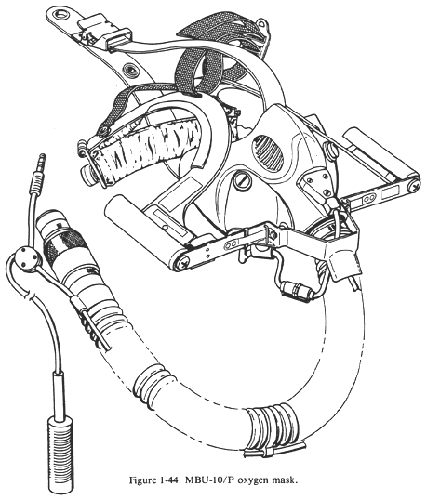
Inhaled
air passes out through the same valve. The exhalation portion of
the valve is constructed so that a pressure of only one
millimeter of mercury greater than the inlet pressure being
supplied by the regulator will force open the valve and allow
exhaled air to flow from the mask. The mask also provides
automatic electrical switching from the headset microphone to
the oxygen mask microphone. This feature permits the air crewman
while wearing the mask to transmit the same as with the headset
microphone, without the need to unplug the headset microphone
and then plug in the oxygen mask microphone. Currently the
MBU-10/P oxygen mask is used on selected C-130 Aircraft.

Sierra
Quick-Don Oxygen Mask
The Sierra Quick-Don oxygen mask (Figure 1-46) is designed to
provide the proper dilution of oxygen with cabin air to conserve
oxygen at lower altitudes. The Sierra Quick-Don mask consists of
a spring loaded head harness, face piece, microphone, and oxygen
supply hose. The mask has two oxygen settings, NORMAL and 100%
OXYGEN. The selector switch is located on the left side of the
regulator attached to the mask. A white button located on the
front of the regulator allows the crew member to receive
additional oxygen under pressure. The Sierra Quick-Don Mask is
carried on some C-9, C-12, CT-39 and T-44 aircraft.
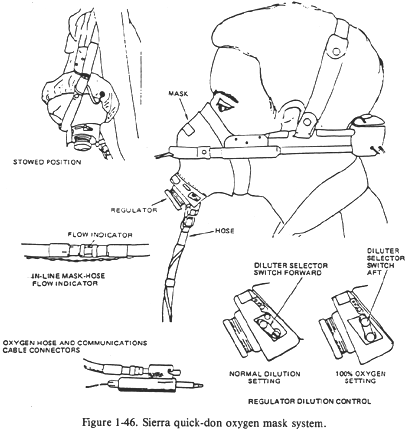
Full
Face Oxygen and Smoke Mask
The full face oxygen and smoke mask (Figure 1-47) is designed to
dispense gaseous oxygen from a demand type regulator to the
user. The smoke mask provides oxygen and face protection to air
crew members who use oxygen equipment only in rare or emergency
situations. The mask also provides protection from smoke, carbon
monoxide, or other incapacitating gases. The full face oxygen
and smoke mask has a single configuration of the face piece,
delivery hose, and MC-3A connector. The mask consists of a
molded rubber face piece with microphone cavity. It has five
fitting straps, an acrylic plastic lens, and exhalation valve.
The delivery hose (K-4 hard hose) is composed of non-stretch,
non-kinking, smooth bore, flexible hose with an integral
corrosion resistant wire. The hose cover is knitted or braided
of tubular polyamide or polyester. The communication cable is
molded into the hose with leads extending for attachment for a
mask mounted microphone. It also has a connection for attaching
to the aircraft communications system. The MC-3A connector is
provided for access to the aircraft oxygen system. The full face
oxygen and smoke mask is carried on P-3 and C-130 aircraft.
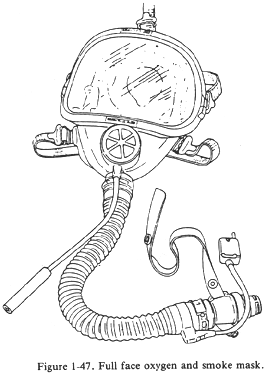
|